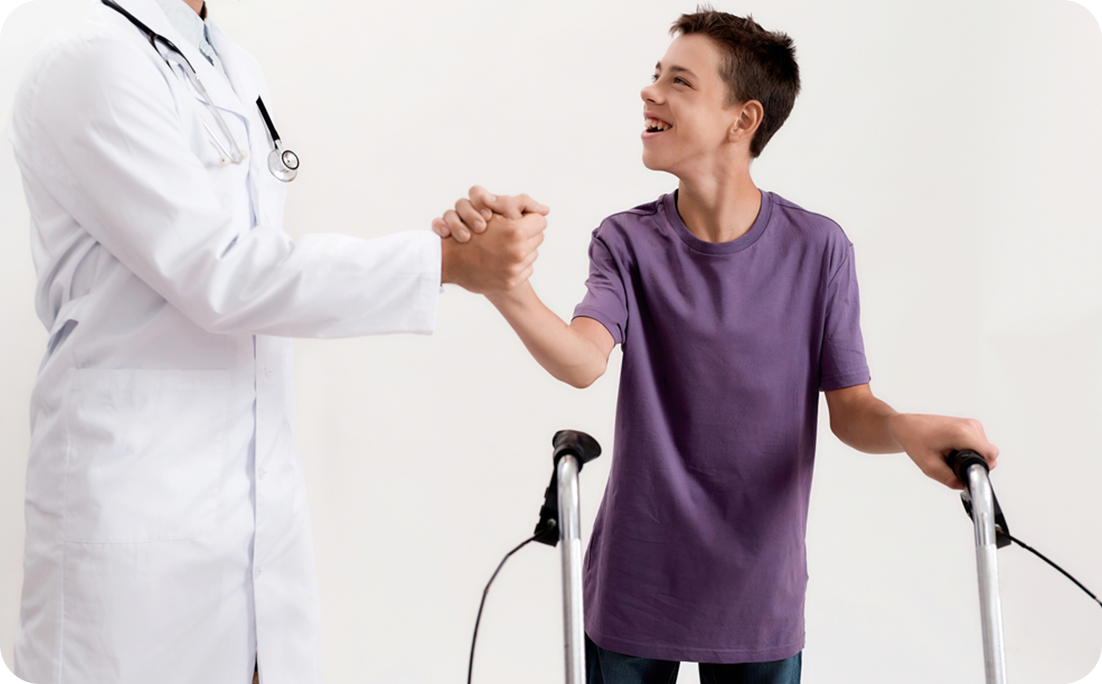What is cerebral palsy?
The term "cerebral" refers to the cerebrum, a portion of the brain that controls motor function. "Palsy" refers to the paralysis of voluntary movement in specific areas of the body.
The cause of cerebral palsy and the impact on function differ from person to person. Some persons with cerebral palsy can walk, but others require assistance. Some people have intellectual limitations; others do not. Epilepsy, blindness, and deafness may also affect patients with cerebral palsy. There is no cure, but therapies can assist.
The symptoms of cerebral palsy may change throughout the child's development, but the disease does not worsen. The condition usually remains the same throughout time.
A child with cerebral palsy may experience the following issues:
- Disabilities with movement and walking
- Difficulty with speech
- Disabilities related to learning
- Cognitive deficits
- Hearing or vision loss
- Epilepsy
- Emotional and behavioral problems
- Spinal deformities
- Joint issues
There are several kinds of cerebral palsy, including:
- Ataxic cerebral palsy is caused by injury to the cerebellum, leading to impaired motor control and movement.
- Athetoid/dyskinetic cerebral palsy is caused by injury to the basal ganglia and/or cerebellum, resulting in fluctuating muscle tone and involuntary movements.
- Hypotonic cerebral palsy, caused by cerebellar impairment, is characterized by floppy muscles, excessive flexibility, and impaired mobility.
- Spastic cerebral palsy, the most frequent variety, is caused by injury to the motor cortex or pyramidal tracts, resulting in tense muscles and jerking motions.
- Multiple areas of brain injury can lead to mixed cerebral palsy.
What causes Cerebral Palsy?
The fundamental causes of CP are brain damage or abnormality, however a variety of factors can cause harm. As a result, the actual cause of cerebral palsy is often unknown. Possible causes include:
- Poor brain development in the womb
- Maternal illnesses or other disorders.
- Disrupted blood supply to the growing brain
- Genetic disorders
- Toxin or drug ingestion during pregnancy
- Head or skull damage after delivery
- Premature birth complications
Cerebral palsy indicators and symptoms.
Cerebral palsy in newborns can produce a wide range of physical and neurological symptoms, which can have a significant impact on a child's development. These cerebral palsy symptoms vary each child, depending on the severity and location of
Physical symptoms.
Symptoms may include muscle contractions, drooling, exaggerated reflexes, floppy muscle tone, and digestive issues.
- Incontinence
- Involuntary motions or tremors
- Lack of coordination and balance
- Difficulty swallowing or sucking
- Problems with movement on one side of the body
- Stiff muscles (spasticity)
Neurological symptoms
- Fluid imbalance can cause cerebral pressure buildup (hydrocephalus)
- Behavioral problems
- Delayed motor skill development
- Speech difficulties (dysarthria)
- Sensory impairments
- Visual/hearing impairment
Cerebral palsy diagnosis.
Cerebral palsy is commonly diagnosed between the ages of 18 months and five years. Although parents and caregivers may be the first to discover signs of cerebral palsy in infants, clinicians are frequently hesitant to make an immediate diagnosis until additional symptoms are observed as the child grows.
Imaging scans are used to diagnose cerebral palsy by detecting brain damage.
Imaging studies used to diagnose cerebral palsy include CT scans, cranial ultrasounds, electroencephalograms (EEG), and MRI scans.
If you believe your kid has developing indicators of cerebral palsy, you should see a professional. A cerebral palsy specialist can examine and do tests to diagnose your child's condition.
Cerebral palsy Treatment
There are numerous approaches to treating cerebral palsy symptoms.
- Actively treating cerebral palsy symptoms is the most effective strategy to ensure a child's optimum quality of life as they grow into adults.
- Cerebral palsy newborns may require early medical intervention to promote brain development. During this stage, there will be more possibilities to repair or improve the child's mobility limits.
Find out more about the various therapies for cerebral palsy below.
Medication
Medication can be used to treat some cerebral palsy symptoms, such as involuntary movement, seizures, and spasticity.
Medication can also be used to treat secondary disorders induced by cerebral palsy, such as incontinence, acid reflux, and behavioral issues.
Therapy
There are numerous therapies available to assist alleviate cerebral palsy symptoms. Therapy can help to increase mobility and cognitive comprehension.
- Physical therapy can alleviate pain and stiffness, improve balance, coordination, and mobility. Physical therapists will utilize specialized equipment to assist your child move freely and live independently.
- Occupational therapy improves fine motor skills and cognitive abilities for children with cerebral palsy, enabling them to do daily tasks and activities.
- Speech therapy improves children's communication and language skills. This sort of therapy instills in children the confidence to learn and socialize.
Speech therapy can also benefit youngsters who have trouble eating and swallowing.
- Surgery may be recommended for children experiencing severe mobility and muscular difficulties. Cerebral palsy surgery can enhance movement in the legs, ankles, feet, hips, wrists, and arms. Muscles, tendons, bones, and nerves are operated on to improve movement in these parts of the body.
Cerebral palsy surgery can improve balance, coordination, and posture, prevent hip dislocation, and spinal deformities, reduce tremors, relieve pain, relieve stiff muscles, and treat co-occurring conditions.
Case Study By

Dr Nishant Soni
(MBBS, MS-Ortho)
Experience
Hand & Reconstructive
Micro Surgeon with 13 yrs
as specialist
Work in Stats till 2023
5000+ Carpal Tunnel Surgery
10010+ Hand Fractures
3000+ Wrist Surgeries
40000+ Happy Patients
Associations
Medanta MedCity
SCI International Hospital
Medanta MedCity
SCI International Hospital
Read More


